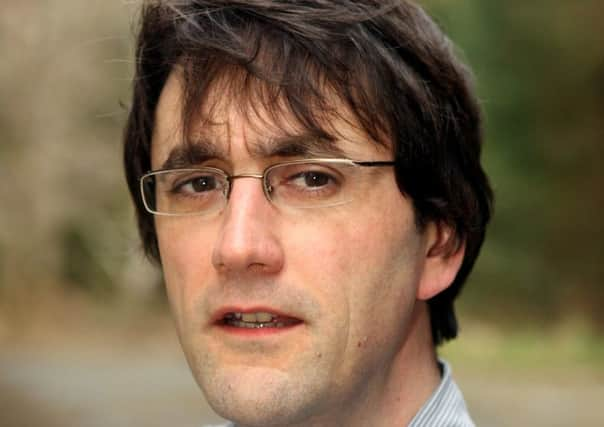Book review: Lie Of The Land by Michael F Russell


Michael F Russell
Lie Of The Land
Polygon, £12.99
GIVEN the success of tartan noir, it is a mystery to me that we have not witnessed a similar phenomenon in other genres from Scottish writers. “Speculative fiction” – the catch-all term to cover science-fiction, fantasy and horror – would seem to be especially tractable to such a renaissance.
Of course, there are Scottish speculative writers – Ken MacLeod and the late Iain M Banks most conspicuously, but also Charles Stross, Hal Duncan and Hannu Rajaniemi; and in fantasy, Ricardo Pinto and Alan Campbell. Denise Mina has written horror graphic novels, with Empathy Is The Enemy and A Sickness In The Family, and there is a strong strain of the science fictional or fantastical in the work of such writers as Alasdair Gray, Andrew Crumey, Michel Faber and Martin Millar. Grant Morrison’s metafictional graphics work, such as Arkham Asylum and Multiversity, are probably the most commercially successful Scottish speculative works.
Advertisement
Hide AdIt is against this backdrop that Michael F Russell’s debut novel comes as such a pleasant surprise – although rather than use the catch-all “speculative”, we might call it an example of “catastrophe fiction”.
Lie Of The Land is set in a near future Scotland where an ecological disaster, referred to as the “white rust”, has ushered in an authoritarian government. Movement is restricted, curfews are in place and the populace is mollified with such innovations as “spraysuits” – a technological prosthesis to allow the fiction of having sex with a partner who is only present digitally.
Carl Shewan is one of a dying breed – an old-fashioned investigative journalist who displays all the blasted idealism and penchant for booze of his many fictional forebears. Shewan’s work is stifled, watered-down and spiked by the powers that be at every turn. But he has one final scoop up his sleeve. He persuades his editor to allow him to travel to Inverlair in the Highlands to meet a contact who has information about SCOPE, the government’s new super-surveillance system. It turns out that the white rust is not what we should be worried about after all.
The novel begins with Shewan already in Inverlair, after the activation of SCOPE. It transpires that everything his source told him – and every concern he could have pushed harder to get into the public domain – was accurate.
One of the most persistent complaints visitors (and residents) make about contemporary Scotland is the patchy mobile phone coverage. This serves as the novel’s clever, twisted conceit. SCOPE has a design flaw, creating a “standing delta wave” (a high amplitude brain wave associated with deep sleep of around 4Hz: that’s your science-y bit) that means everyone under its electromagnetic embrace immediately sinks into a coma. Shewan’s source chooses Inverlair because it has no coverage. While the country dies in its sleep, the residents of Inverlair are in a pocket of safety. If they walk far enough to get the equivalent of two bars on their mobile, they start to have nosebleeds and migraines, before succumbing. When we first meet the protagonist, he is just recovering from having tarried too long in the delta wave area. Flashbacks fill out his journey towards Inverlair, while the narrative progresses with the community’s attempts to cope with their isolated salvation.
It’s not a spoiler to say that the claustrophobia begins to get to people. As scarce resources dwindle, those who take charge replicate the worst excesses of the government that was; alcohol and drug use spirals; teenagers dare each other over how far they can survive into the delta wave’s zone; sexual assault is rife; and small men who want to be big men see their chance and use every opportunity to tighten their grasp. There’s a suppurating resentment towards outsiders; chippy paranoia and fever-pitch gossip flourish; and a police force without backup is thirled to the local vendettas – the Scotland of the near future bears more than a passing resemblance to the Scotland so fearfully described by George Douglas Brown in The House With The Green Shutters, J MacDougall Hay’s Gillespie and John Buchan’s Witch Wood.
Advertisement
Hide AdRussell’s premise is similar to Stephen King’s in Under The Dome, but, I have to say, he does a better job with the conceit. While King, as usual, fluffs the ending (childish aliens did it!), Russell manages to give a coherent reason for the predicament, build to a closure without it becoming a black and white shoot-out, and suggest that the story of Shewan and Inverlair may not be over. Despite the horrors that slowly, slyly emerge, there are also passages of genuine beauty, as Shewan works with an old ghillie who is dying because his emphysema nanotech drugs can no longer be supplied.
He has to learn how to gralloch and how to bide his time, how to set a trap and how to do a harsh thing kindly. He has to man up – especially as a local girl is pregnant with his child. But this is not macho survivalism; rather, it is about how to become decent.
Advertisement
Hide AdThe great Brian Aldiss famously dismissed some novels in this form as “cosy catastrophe”. Usually they take the form of a bourgeois man liberated from his etiquette, driving a car around empty streets, being heroic and ending up with more power and property. Russell avoids this. It is as cosy as a handful of gorse raked across your back. It announces a talent to be followed closely.